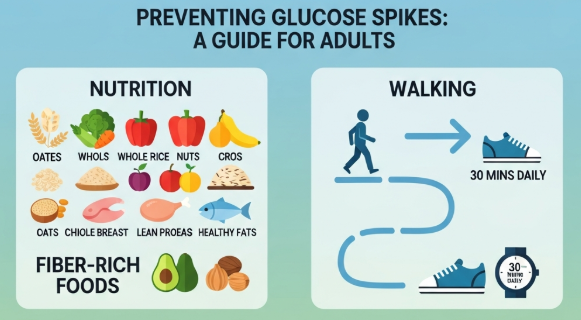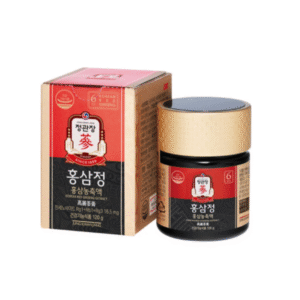Introduction: Why Blood Sugar Matters Even If You’re Not Diabetic
Most people think blood sugar management is only important for individuals with diabetes. But science now reveals something different — even healthy adults without diabetes experience frequent glucose spikes every day, and those spikes silently influence energy, weight, mood, skin, metabolism, and long-term health.
Adults aged 25–45 are especially vulnerable because of:
- busy schedules
- stress from work
- irregular meals
- high intake of coffee, snacks, and processed food
- sedentary habits
- disrupted sleep
What’s surprising is this:
👉 Even a “normal weight” person can have unstable glucose levels and not know it.
Understanding blood sugar isn’t about avoiding disease —
it’s about improving daily performance, mental clarity, hormones, cravings, and long-term vitality.
CHAPTER 1 — What Exactly Is a Glucose Spike?
A glucose spike happens when blood sugar rises too high, too fast, after eating or drinking.
This commonly occurs after consuming:
- sugary drinks
- pastries, cakes, and sweet snacks
- white rice, noodles, pasta, and bread
- breakfast cereals
- bubble tea
- high-carb meals without protein or fiber
When glucose spikes, your body responds by releasing a large amount of insulin — a hormone that pushes sugar into cells.
Why this becomes a problem
Frequent spikes lead to:
- energy crashes
- heightened hunger
- fat storage
- inflammation
- hormonal imbalance
- accelerated aging
- increased risk of diabetes long-term
This cycle quietly affects millions of adults who have never been diagnosed with any condition.
CHAPTER 2 — The Hidden Effects of Blood Sugar on Daily Life
1. Energy & Fatigue
If you:
- feel energetic after eating but crash after 1–2 hours
- need coffee repeatedly
- wake up tired
- crave sweets at night
You are likely experiencing glucose rollercoasters.
2. Mood & Anxiety
Glucose spikes and crashes affect neurotransmitters like serotonin and dopamine.
This can cause:
- irritability
- poor concentration
- low motivation
- “hanger” (hungry + angry)
- sudden mood swings
Many people blame stress, but the root cause is often unstable blood sugar.
3. Weight Management
Insulin signals the body to store fat, especially around the stomach.
Even if you eat “healthy,” frequent spikes make weight loss harder due to:
- appetite increase
- cravings
- reduced fat-burning
4. Hormones
For adults 25–45, hormones are more sensitive than people think.
Glucose instability can disturb:
- cortisol (stress hormone)
- insulin
- leptin & ghrelin (hunger hormones)
- sex hormones (testosterone, estrogen, progesterone)
This contributes to:
- PMS
- acne
- low libido
- difficulty losing weight
5. Skin Health
High sugar accelerates glycation, a process that makes collagen stiff and weak.
Signs include:
- dull skin
- premature lines
- acne breakouts
- inflammation
Your skincare routine matters —
but your blood sugar matters more.
CHAPTER 3 — Blood Sugar Problems That Happen Even Without Diabetes
A person can have normal fasting glucose but still suffer from:
- insulin resistance
- reactive hypoglycemia
- metabolic inflexibility
- high post-meal spikes
These issues normally remain undetected until years later.
Warning signs of hidden glucose issues
- frequent tiredness
- cravings for sweets
- always hungry again after 1–2 hours
- difficulty losing weight
- belly fat
- anxiety after meals
- brain fog
- sweating/shakiness when hungry
- sleep issues
If you experience 3 or more of these, your blood sugar needs attention.
CHAPTER 4 — Why Adults 25–45 Are at Highest Risk
1. Dietary Patterns
Coffee + bread for breakfast
Late lunch
Sugary snacks
Heavy dinner
Bubble tea at night
This lifestyle produces constant glucose instability.
2. Stress & Cortisol
When stressed, the body releases glucose into the bloodstream.
High cortisol = higher blood sugar.
So even without eating sweets, stress alone can spike glucose.
3. Sedentary Jobs
Sitting 8–10 hours a day slows down glucose metabolism by 40–60%.
4. Sleep Deprivation
Just one night of poor sleep makes the body more insulin-resistant.
CHAPTER 5 — Practical Blood Sugar Hacks That Actually Work
These are scientifically proven strategies that work for almost everyone.
Hack #1 — Always Eat Fiber or Vegetables First
Eating veggies before carbohydrates slows digestion and reduces spikes by up to 30–40%.
Examples:
- salad before pasta
- spinach before rice
- cucumbers or carrots before noodles
This is called “food sequencing.”
Hack #2 — Add Protein & Healthy Fats to Carbs
Carbs alone spike glucose.
Carbs + protein/fat = slower release.
Examples:
- rice + chicken + veggies
- oatmeal + eggs
- fruit + nuts
- bread + avocado
Hack #3 — Never Drink Sugar on an Empty Stomach
Soft drinks, fruit juice, sweet coffee, and bubble tea create the fastest spikes.
If you must drink:
- drink after eating
- pair with protein
- or choose unsweetened options
Hack #4 — Take a 10–15 Minute Walk After Meals
Walking after eating can reduce glucose spikes by up to 40%.
This is one of the most powerful, simple habits for adults with busy schedules.
Hack #5 — Prioritize a High-Protein Breakfast
Eating carbs for breakfast sets you up for all-day cravings.
Better breakfast ideas:
- eggs + vegetables
- Greek yogurt + berries
- chicken breast + avocado
- tofu scramble
Avoid:
- sweet coffee
- pastries
- white bread
- sugary cereal
- milk tea
Hack #6 — Drink Water Before Eating
This improves digestion and reduces overeating.
Hack #7 — Get Enough Sleep
Aim for 7–8 hours.
Lack of sleep + late snacking = insulin resistance.
CHAPTER 6 — What to Eat Daily for Stable Blood Sugar
Good Choices
✔ high-protein foods
✔ leafy greens
✔ nuts & seeds
✔ whole grains
✔ sweet potatoes
✔ low-GI fruits (berries, apples, oranges, kiwi)
✔ unsweetened tea or coffee
✔ high-fiber vegetables
Limit These
✘ sugary drinks
✘ white bread
✘ pastries
✘ instant noodles
✘ white rice in large quantities
✘ sweet snacks
Smart Carb Swaps
- white rice → brown rice or quinoa
- white bread → sourdough or whole grain
- sweet snacks → nuts or fruit
- sugary drinks → lemon water
CHAPTER 7 — Supplements That Support Glucose Stability
(General wellness information — not medical advice)
1. Korean Red Ginseng
Well-known for:
- improving energy
- supporting metabolism
- helping insulin sensitivity
- reducing fatigue
2. Omega-3
Helps reduce inflammation.
3. Magnesium
Supports glucose metabolism.
4. Berberine
Known for stabilizing insulin response.
5. Green Tea Extract
Helps with fat oxidation and glucose control.
CHAPTER 8 — Long-Term Benefits of Managing Blood Sugar
Stabilizing glucose helps:
- steady energy
- healthier mood
- fewer cravings
- reduced belly fat
- better skin
- improved hormonal balance
- enhanced brain performance
- better sleep
- reduced long-term disease risk
The earlier you start, the better the results.
CONCLUSION
Blood sugar management isn’t just for diabetics.
It is a lifestyle strategy that boosts energy, protects hormones, improves mood, sharpen focus, and supports long-term health — especially for adults aged 25–45.
By mastering simple daily habits, you can transform your health from the inside out.







